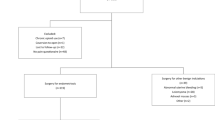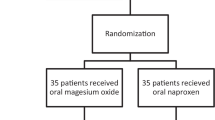Abstract
Aims
In this prospective observational clinical study, we aimed to evaluate the relationship between serum mu-opioid receptor (MOR) levels according to menstrual cycle phases on postoperative pain scores and analgesic requirements.
Methods
A total of 80 female patients undergoing laparoscopic surgery were divided into two groups according to the phases of the menstrual cycle as follicular and luteal. Postoperative pain scores, total tramadol consumptions, and numbers of demands on patient-controlled analgesia (PCA) of the patients were recorded at 5 time points (T0: in the recovery room, T1: 1st hour in the ward, T2: 6th hour in the ward, T3: 12th hour in the ward, T4: 24th hour in the ward). Serum MOR concentrations were measured by enzyme-linked immunosorbent assay.
Results
The mean serum MOR levels were significantly higher in the follicular group (275 ± 32 pg/ml) compared to the luteal group (254 ± 28 pg/ml) (p = 0.003). Total tramadol consumption (T0, T2, and T3) was significantly higher in the luteal group (p = 0.031, p = 0.012, p = 0.017, respectively). Postoperative pain scores did not differ significantly between the groups. With the exception of T4 (p = 0.057), the number of demands on PCA was significantly higher in the luteal group. However, multivariate logistic regression analysis showed that serum MOR levels were affected by the menstrual cycle phase (follicular) (β = 0.361) (p = 0.001).
Conclusions
Our study revealed that patients during the follicular phase with higher serum MOR levels consumed less opioid analgesic postoperatively. More comprehensive studies are needed to determine the relationship between serum MOR levels and menstrual cycle phases as well as postoperative pain. (Trial registration number: NCT04690491 www.clinicaltrials.gov).
Graphical abstract




Similar content being viewed by others
References
Zeeni C, Chamsy D, Khalil A et al (2020) Effect of postoperative Trendelenburg position on shoulder pain after gynecological laparoscopic procedures: a randomized clinical trial. BMC Anesthesiol 20(27):1–7. https://doi.org/10.1186/s12871-020-0946-9
Wiesenfeld-Hallin Z (2005) Sex differences in pain perception. Gend Med 3(2):137–145
Hussain AM, Khan FA, Ahmed A et al (2013) Effect of gender on pain perception and analgesic consumption in laparoscopic cholecystectomy: an observational study. J Anaesthesiol Clin Pharmacol 29(3):337–341. https://doi.org/10.4103/0970-9185.117095
Lee CWS, Ho IK (2013) Sex differences in opioid analgesia and addiction: interactions among opioid receptors and estrogen receptors. Mol Pain 9(1):1–10
Piroli A, Mattei A, Carta G et al (2019) Influence of the menstrual cycle phase on pain perception and analgesic requirements in young women undergoing gynecological laparoscopy. Pain Pract 19(2):140–148. https://doi.org/10.1111/papr.12727
Iacovides S, Avidon I, Baker FC (2015) Does pain vary across the menstrual cycle? A Rev Eur J Pain 19(10):1389–1405. https://doi.org/10.1002/ejp.714
Rezaii T, Hirschberg AL, Carlström K et al (2012) The influence of menstrual phases on pain modulation in healthy women. J Pain 13(7):646–655. https://doi.org/10.1016/j.jpain.2012.04.002
Sener EB, Kocamanoglu S, Cetinkaya MB et al (2005) Effects of menstrual cycle on postoperative analgesic requirements, agitation, incidence of nausea and vomiting after gynecological laparoscopy. Gynecol Obstet Invest 59(1):49–53. https://doi.org/10.1159/000081222
Jewelewicz R (1984) The role of endogenous opioid peptides in control of the menstrual cycle. Fertil Steril 42(5):683–685
Gencer M, Gocmen AY (2020) The relationship between the level of μ-opioid receptor (μORs) and postoperative analgesic use in patients undergoing septoplasty: a prospective randomized controlled trial. BMC Anesthesiol 20(1):1–15. https://doi.org/10.21203/rs.3.rs-19493/v5
Liang X, Liu R, Chen C et al (2016) Opioid system modulates the immune function: a review. Transl Perioper Pain Med 1(1):5–13
Al-Hakeim H, Al-Fadhel S, Al-Dujaili AH, Maes M (2019) In major depression, increased serum dynorphin and kappa opioid receptor levels are positively associated with mu opioid receptor levels and immune activation and are attenuated by nicotine dependence (April):1–38. Available from: https://doi.org/10.20944/preprints201904.0176.v1
Al-Hakeim HK, Zeki Al-Fadhel S, Al-Dujaili AH, Maes M (2020) In major depression, increased kappa and mu opioid receptor levels are associated with immune activation. Acta Neuropsychiatr 32(2):99–108
Almulla AF, Al-Rawi KF, Maes M, Al-Hakeim HK (2021) In schizophrenia, immune-inflammatory pathways are strongly associated with depressive and anxiety symptoms, which are part of a latent trait which comprises neurocognitive impairments and schizophrenia symptoms. J Affect Disord 287:316–326. https://doi.org/10.1016/j.jad.2021.03.062
Al-Fadhel SZ, Al-Hakeim HK, Al-Dujaili AH, Maes M (2019) IL-10 is associated with increased mu-opioid receptor levels in major depressive disorder. Eur Psychiatry 57:46–51. https://doi.org/10.1016/j.eurpsy.2018.10.001
Vidal EL, Patel NA, Fiala M et al (1998) Interleukin-1 induces the expression of μ opioid receptors in endothelial cells. Immunopharmacology 1;38(3):261–6
Böttcher B, Seeber B, Leyendecker G, Wildt L (2017) Impact of the opioid system on the reproductive axis. Am Soc Reproduct Med. https://doi.org/10.1016/j.fertnstert.2017.06.009
Totorikaguena L, Olabarrieta E, Matorras R et al (2017) Mu opioid receptor in the human endometrium: dynamics of its expression and localization during the menstrual cycle. Fertil Steril 107(4):1070–1077. https://doi.org/10.1016/j.fertnstert.2017.01.020
Lee J, Lee J, Ko S (2014) The relationship between serum progesterone concentration and anesthetic and analgesic requirements: a prospective observational study of parturients undergoing cesarean delivery. Anesth Analg 119(4):901–905. https://doi.org/10.1213/ANE.0000000000000366
Yang MMH, Hartley RL, Leung AA et al (2019) Preoperative predictors of poor acute postoperative pain control: a systematic review and meta-analysis. BMJ Open 9:e025091. https://doi.org/10.1136/bmjopen-2018-025091
Ring C, Veldhuijzen van Zanten JJCS, Kavussanu M (2009) Effects of sex, phase of the menstrual cycle and gonadal hormones on pain in healthy humans. Biol Psychol 81(3):189–191. https://doi.org/10.1016/j.biopsycho.2009.04.004
Xie N, Matigian N, Vithanage T et al (2018) Effect of perioperative opioids on cancer-relevant circulating parameters: mu opioid receptor and toll-like receptor 4 activation potential, and proteolytic profile. Clin Cancer Res 24(10):2319–2327
Acknowledgements
The authors would also like to thank all of the staff in the Department of Anesthesiology and Gynecology for their fundamental support during the study (Yozgat Bozok University, Medical Faculty Hospital, Yozgat, Turkey). In addition, the authors are grateful to the anesthesiologists M.D. (Ahmet Yuksek and Cevdet Yardımcı) and anesthesiology residents for their support throughout the study.
Author information
Authors and Affiliations
Contributions
All authors have read and approved the final version of the manuscript.
Corresponding author
Ethics declarations
Competing interests
The authors declare no competing interests.
Additional information
Publisher's Note
Springer Nature remains neutral with regard to jurisdictional claims in published maps and institutional affiliations.
Rights and permissions
Springer Nature or its licensor holds exclusive rights to this article under a publishing agreement with the author(s) or other rightsholder(s); author self-archiving of the accepted manuscript version of this article is solely governed by the terms of such publishing agreement and applicable law.
About this article
Cite this article
Miniksar, Ö.H., Onat, T., Gocmen, A.Y. et al. Serum levels of mu-opioid receptor according to menstrual cycle phases are associated with postoperative pain and opioid consumption in laparoscopic gynecological surgeries: a prospective observational study. Ir J Med Sci 192, 1847–1854 (2023). https://doi.org/10.1007/s11845-022-03146-z
Received:
Accepted:
Published:
Issue Date:
DOI: https://doi.org/10.1007/s11845-022-03146-z




